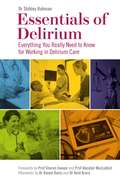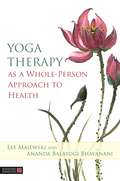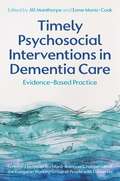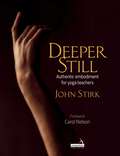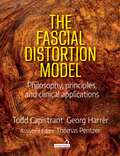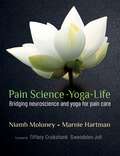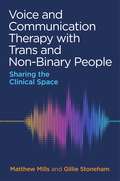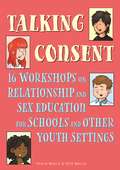- Table View
- List View
Essentials of Delirium: Everything You Really Need to Know for Working in Delirium Care
by Dr Shibley RahmanThis introductory reference guide provides in-depth knowledge and information for students and practitioners to help better their response to patients with delirium. Detailing all aspects of delirium care, including ethical considerations, it is an essential resource in widening professional understanding and care improvement.
Coping with Mild Cognitive Impairment (MCI): A Guide to Managing Memory Loss, Effective Brain Training and Reducing the Risk of Dementia
by Mary JordanSelected for Reading Well for Dementia 2024: endorsed by health experts, charities and people affected by dementia.Adults are being increasingly diagnosed with Mild Cognitive Impairment (MCI), and this book provides strategies for concerned individuals to help slow the onset of the condition. Around 50% of adults with MCI go on to develop dementia, but research shows that self-help through early intervention and preventative measures can hugely slow this down.The self-help measures in this book include memory aids, health and lifestyle changes, activities, therapies and technological aids. All of them are known to improve cognition and can be incorporated into daily life. Every measure is firmly based in current research, and this book is also applicable to those with early-stage dementia wishing to delay the onset of more severe cognitive impairment.Given the paramount importance of early intervention to prevent cognitive impairment worsening, this book is essential reading for any older individual wanting the best strategies to help with how to do this in practice.
Integrating Philosophy in Yoga Teaching and Practice: A Practical Guide
by Wendy TeasdillProviding simple explanations of the various philosophical strands underpinning yoga as well as guidance on how to integrate them into teaching, this practical work from Wendy Teasdill concerns itself with values that are often lost in modern-day practice. It looks at balance, moderation, introspection, self-development and liberation, integrating these into asana practices in a way that deepens the experience. Each chapter covers a particular aspect of yoga philosophy in the key texts, with links to asana, pranayama, moral codes, as well as some contemporary issues such as orthorexia, the question of cultural appropriation, the role of the guru, misuse of power and recognition of authenticity in an ever-evolving scene. By presenting practical skills rooted in yoga's long history, Integrating Philosophy in Yoga Teaching and Practice makes the transition from physical to metaphysical easy for both yoga teachers and students.
Restorative Yoga for Ethnic and Race-Based Stress and Trauma: A Visual Introduction (Therapeutic Parenting Bks.)
by Gail ParkerPresenting ways in which Restorative Yoga can contribute to healing emotional wounds, this book invites yoga teachers, therapists and practitioners to consider the psychological impact of ethnic and race-based stress and trauma. It aids in the process of uncovering, examining, and healing one's own emotional wounds and offers insight into avoiding wounding or re-wounding others. The book describes how race-based traumatic stress differs from PTSD and why a more targeted approach to treatment is necessary, as well as what can trigger it. It also considers the implications of an increasingly racially and ethnically diverse and global yoga community, as well as the importance of creating conscious yoga communities of support and connection, where issues of race and ethnicity are discussed openly, non-defensively and constructively.By providing a therapeutic structure that assists those directly and indirectly impacted by ethnic and race-based stress and trauma, Restorative Yoga for Ethnic and Race-Based Stress and Trauma provides valuable tools for aiding in the processing of stressful experiences and in trauma recovery.
Yoga Therapy as a Whole-Person Approach to Health
by Lee Majewski Ananda Balayogi BhavananiIn this book, Lee Majewski and Ananda Bhavanani define yoga and yoga therapy as a whole person practice, demonstrating how it can help the individual to heal through their own mechanisms. The authors bring yogic concepts from theory into everyday life, exploring how yoga therapy can work with all levels of a human being at the same time (physical, energetic, emotional, intellectual and spiritual) and demonstrating that, when applied correctly, it can assist healing and facilitate an improved quality of life.The book covers deep yogic work and how it applies to cancer patients, as well as a range of other chronic conditions including respiratory diseases, cardiovascular diseases and diabetes. For each of these conditions the authors explore how yoga therapy can go beyond alleviating symptoms and work to heal the whole person.
Yoga and Resilience: Empowering Practices for Survivors of Sexual Trauma
by Danielle RousseauYoga and Resilience is part of a larger series put out by the Yoga Service Council in collaboration with the Omega Institute. To date, there have been three texts published: Best Practices for Yoga in Schools, Best Practices for Yoga with Veterans, and Best Practices for Yoga in the Criminal Justice System. This body of work takes a unique and groundbreaking approach of co-creation, calling on a diverse array of leading experts in the fields of trauma and yoga, to collaborate and distill best practices that will inform the fields of mental health, trauma-informed yoga, yoga service, and yoga more generally. Contributors and authors met during two symposia and engaged in an ongoing collaborative process resulting in the current text.Yoga and Resilience: Empowering Practices for Survivors of Sexual Trauma: Supports a holistic approach to ameliorating the impacts of traumatic stress, and specifically the impacts of sexual trauma. Serves as a resource to survivors, yoga teachers and practitioners, yoga service providers, trauma practitioners, and agency administrators among others. Presents a foundational understanding of sexual trauma and illuminates current best practices for integrating trauma-informed yoga and mindfulness practices into work with persons and systems impacted by sexual trauma. Explores an approach that moves beyond trauma-informed practice to a focus on resilience and universal inclusivity. Provides concrete tools to serve survivors better and to ensure that teachers and administrators not only seek to minimize harm but also combat sexual violence and its perpetration within yoga contexts.Contributors to the book:Keyona Aviles, Jacoby Ballard, Lisa Boldin, Maya Breuer, Regine Clermont, Colleen DeVirgiliis, Alexis Donahue, Pamela Stokes Eggleston, Jennifer Cohen Harper, Dani Harris, Nan Herron, Daniel Hickman, Diana Hoscheit, Beth Jones, Sue Jones, James Jurgensen, Mark A. Lilly, Jana Long, Anneke Lucas, Amanda J.G. Napior, Amina Naru, Emanuel "Manny" Salazar, Austin K. Sanderson, Lidia Snyder, Nicole Steward, Rosa Vissers, Kimberleigh Weiss-Lewit, Ann Wilkinson
Reiki in Clinical Practice: A Science-Based Guide
by Ann BaldwinReiki is a healing technique, using gentle touch with the hands placed on or slightly away from the body to optimize physical, mental and emotional health. It is based on the assumption that the flow of energy through the body can be supported and adjusted to promote wellness.Reiki in Clinical Practice is aimed at two main groups: 'medical' practitioners and those with a 'medical' background such as nurses, osteopaths, physical therapists, who may be familiar with Reiki but lack an evidence-based guide on conditions for which Reiki is most effective and who want the 'ammunition' to justify its use in their practice; those unfamiliar with Reiki but who are interested in finding how it can benefit their patients.The book provides an accurate description of Reiki, based on qualitative and quantitative scientific evidence, in terms of how it can be used in medical settings to benefit patients of all types, physiologically and psychologically. It achieves this by following the journey of the author (a scientist), starting from her unsolicited encounter with Reiki and personal observations to her continuing testing of its validity and her quest to determine its effectiveness through robust, scientific investigation.The author distils the essence of the currently peer-reviewed published research to produce a clear outline of the effectiveness of Reiki in alleviating disease and imbalance in various body systems. She will provide a summary of the effectiveness of Reiki (based on a review of surveys of its use) in various circumstances and locations.She presents possible mechanisms by which Reiki may exert its effects. Unlike most books about Reiki, the book is written in a scientific style with which medical practitioners are familiar (clear, precise, logical and concise), so they will be more likely to read it, judge the evidence for themselves, and hopefully support, extend and develop Reiki treatment and training programs so that their patients will have more access to a non-invasive, inexpensive complementary therapy to assist in their healing.
Timely Psychosocial Interventions in Dementia Care: Evidence-Based Practice
by Jill Manthorpe and Esme Moniz-CookThis new edited volume seeks to meet the growing need for ways to support people with dementia across the whole course and trajectory of dementia care, with a wide scope of expertise.The book addresses how practitioners and carers can apply psychosocial interventions - which take into consideration the individual, social and environmental aspects of a person's life - across this trajectory, right from the earliest stages through to practice in care home settings. Divided into four sections, each covers a different context in which people with dementia can be supported: at home; in community settings; family and carer support; and those in care homes and hospitals. In addition, there is a distinct focus throughout on evidence-based practice and its implementation in real-world settings. This book is essential reading for any practitioner and caregiver wanting to support people with dementia.
Everything Moves: How Biotensegrity Informs Human Movement
by Susan Lowell de Solórzano'What a multi-sensory pleasure in learning! I will be a better teacher and better clinician using what I am learning from this book.' Carol M Davis DPT, EdD, MS, FAPTAThe emerging science of biotensegrity provides a fresh context for re-thinking our understanding of human movement, but its complexities can be formidable. Bodywork and movement professionals looking for an accessible and relevant guide to the concept and application of biotensegrity need look no further than Everything Moves: How biotensegrity informs human movement.In order to work with our own bodies and the bodies of our students, clients and teams most effectively, we need to understand the nature of our human structure. Everything Moves offers the enquiring bodyworker or movement professional, who wants to take their understanding of how to apply biotensegrity in their work to the next level, a practical and relatable guide to the biotensegral nature of our bodies, in which all of the parts are one, yet all are constantly changing.Throughout Everything Moves, concepts and ideas are presented with activities and exercises to make them tangible, accessible and applicable. The material presented is suitable for coaches and movement teachers new to biotensegrity, as well as those with more advanced levels of understanding.Whether your focus is performance, sports, Alexander Technique, Feldenkrais, yoga, Pilates, martial arts, or dance, any arena in which bodies move can be informed by Everything Moves!
The Every Body Book: The LGBTQ+ Inclusive Guide for Kids about Sex, Gender, Bodies, and Families
by Rachel E. SimonAn illustrated LGBTQ+ inclusive kid's guide to sex and relationship education that includes children and families of all genders and sexual orientations, covering puberty, hormones, consent, sex, pregnancy and safety.
Yoga Therapy for Diabetes
by Evan SorokaApproaching diabetes from a multidimensional perspective, Evan Soroka links the practices and philosophy of yoga with science and lived experience. In this book, she addresses the major challenges of type 1 and type 2 diabetes, providing descriptive practices including spinal movements, breathing techniques and meditation.By giving yoga therapists and yoga teachers the tools to encourage a positive mindset in the person with diabetes and therefore putting them in charge of their own health, this manual helps to identify what might be out of balance and how to restore it.
Clouds Over Qingcheng Mountain: A Practice Guide to Daoist Health Cultivation
by Wang YunImmersing the mind with the concepts of the Daoist path of health and immortality, Clouds over Qingcheng Mountain invokes the sacred birthplace of one of China's mystical mountains that has stimulated both mind and body for generations.Whilst the first volume, Climbing the Steps to Qingcheng Mountain, invited the reader to travel across time and through the history of China and Daoism, Clouds over Qingcheng Mountain is more focused in the book's purpose. Wang Yun places special focus on relaxation and the breath through five sets of foundational yet all-encompassing practices, such as posting, to deepen both themes. He offers tales from his life and journey, along with accessible tools to strengthen both body and qi.Bridging the gap between practical experience and philosophical background, Clouds over Qingcheng Mountain simplifies the complex practices of Daoism handed down by generations of accomplished Masters, and gifts the reader with its most valuable aspects for a modern world.
Deeper Still: Authentic Embodiment for Yoga Teachers
by John StirkDeeper Still is the next stage of an ongoing process and a consequence of further inquiry into the yoga experience from author John Stirk. Following on from The Original Body this book invites an even deeper immersion into the reality of practice and the totality of personal experience in accessing the power of our inner teacher.As the theme of this book unfolds the reader is invited towards a sensory understanding leading to profound insight. Teachers using this book will be able to share with their students the clarity, mental space and basic wisdom that emerges as a result of their awakening physiology. We may frequently acknowledge that we are there with the group. Experience may tell us that 'there-ness' is not fixed, that it is based on an unknown element upon which all creativity is founded. Deeper Still goes beyond current experience and invites teachers to write their own story, develop their own script, ride the uncatchable wave that might be called yoga, and open up creativity to the next level.Deeper Still enables teachers to take their students to a deeper dimension. It also:provides a basis for off the chart experiencesappeals to the depth mind through a deepening physical experienceinvites a more profound contact with groupsbrings out the essence of yoga in students as a consequence of a deeper creativityhighlights emergent insight as a feature of group workblends an ancient concept with modern western yogadraws attention to the relationship between soft tissue sensitivity and the quality of xonsciousnessexamines the potential for abundant resonance in group work and the so called 'universal experience'
The Family Experience of Dementia: A Reflective Workbook for Professionals
by Gary Morris Jack MorrisDementia not only affects the person presented with the diagnosis, but their family and friends too. This book provides practitioners with strategies to support the whole family and understand their dementia journey both pre- and post-diagnosis. This is facilitated through a series of activities and reflective prompts. There is also a dedicated chapter offering structured exercises for health and social care practitioners and students. The book introduces the Lawrence family, where Peter has been diagnosed with dementia, and provides perspectives from each family member, allowing practitioners to become acquainted with the lived experience of everyone involved. The reflective questions allow readers to become actively engaged to maximise their knowledge and understanding, and to better contextualize what the dementia experience feels like for family and friends. With its focus on the all-important lived experience of the whole family during the diagnostic process and beyond, this is essential reading for any practitioner working with people with dementia.
Doing Relationship-Centred Dementia Care: Learning From Each Other for Better Dementia Support
by David I. ReidRelationship-centred approaches to dementia care are imperative for enhancing wellbeing. Theory, case examples and tips for practice ensure that dementia care services can establish and draw on positive relationships between people with dementia, families, staff, care homes, communities and the wider health and social care system.
The Fascial Distortion Model: Philosophy, Principles and Clinical Applications
by Todd Capistrant Georg Harrer Thomas PentzerThe Fascial Distortion Model (FDM) was introduced by the American physician Stephen Typaldos (1957-2006). In this model all injuries and other conditions causing pain or disability are seen as arising from specific distortions of the connective tissue.This highly illustrated and very practical text and manual covers in detail the theoretical framework of the model, and approaches to manual therapy treatment based on an understanding of the FDM. The authors systematically cover all disorders likely to be encountered by the therapist, and provide comprehensive guidance about when it is appropriate to use FDM and how best to employ these approaches in treatment.The book is therefore of interest and value to all practitioners who want to understand the FDM and to incorporate its techniques into their therapeutic practice. This is also a comprehensive textbook and manual for anyone studying on FDM courses and for specific qualifications.
Pain Science - Yoga - Life: Bridging neuroscience and yoga for pain care
by Niamh Moloney Marnie HartmanPain Science Yoga Life combines the neuroscience of pain with yoga philosophy and practice for pain care. Rooted in evidence-based practice, this book is a unique blend of the science of pain, the art and science of yoga and its practical application. It aims to bridge the gap that exists between a person in pain and their ability to move beyond suffering and back to life.Part One sets the foundation for pain science fundamentals, the Eight Limbs of Yoga, as well as mindfulness practices to aid in shifting perspectives and enhance interventions for those struggling with persistent pain.Part Two delves into key dimensions of pain and its care, such as perception, emotions, physical contributions, exercise and sleep. Each chapter has three sections:Headspace: presents a review of pain neuroscience and yoga research related to each dimension.Out of the Head and onto the Mat: translates information from 'Headspace' into an experiential practice on the yoga mat.Off the Mat and into Life: demonstrates how to extend knowledge and practice into daily living.Pain Science Yoga Life is a valuable resource for healthcare and yoga professionals, and is designed to deepen pain science knowledge and skills in the use of yoga for pain care. The combination of scientific information along with practice sections will enable professionals to directly apply the information in the clinic or studio. This book will also engage anyone who has an interest in deepening their understanding of pain and the use of yoga to gain resilience in the face of pain.
Dementia-Friendly Communities: Why We Need Them and How We Can Create Them
by Susan McFaddenCreating dementia-friendly communities can give people with dementia the chance to continue meaningful lives with reciprocal personal relationships. Underpinning successful dementia-friendly communities is an awareness of people with dementia as active citizens and the importance of supporting engagement in community life. This book offers an overview of the dementia-friendly communities movement, showing the many benefits of this approach. It describes community initiatives from across the globe, such as Dementia Friends, memory cafes, and creative engagement with the arts through organizations like TimeSlips. This compassionate book tells another story about dementia, away from negative stereotypes. This alternative approach claims people can retain a sense of dignity, hold onto hope, sustain meaningful relationships, and live with a sense of purpose with support from their communities.
Voice and Communication Therapy with Trans and Non-Binary People: Sharing the Clinical Space
by Gillie Stoneham Matthew MillsSpecifically aimed at Speech and Language Therapists (SLTs) and voice practitioners, this book follows up from the authors' first book, The Voice Book for Trans and Non-Binary People. It sets out cultural competence, psychological and vocal skills, group activities and improvisations frameworks and exercises to helps SLTs develop their skills for working with trans and non-binary clients, including facilitation and coaching, emotional intelligence, role-play and solution-focused therapy, narrative therapy practices. It also includes many contributions from the trans community and a range of clinical professionals to emphasise the collaborative space.Written by two leading authorities on voice and communication therapy for trans people, this is an essential and authoritative resource for anyone working with trans and non-binary clients who are seeking their voice exploration.
Talking Consent: 16 Workshops on Relationship and Sex Education for Schools and Other Youth Settings
by Pete Wallis Thalia WallisThis book gives parents and professionals guidance on how to talk to young people about consent, pornography, sexting, sex in the media, and other related topics, showing how to discuss this complicated issues in constructive ways.
Holding Space: The Creative Performance and Voice Workbook for Yoga Teachers
by Sarah ScharfHelping yoga teachers improve their vocal skills, this expert guide introduces theatre, improvisational and performance techniques to build confidence in teachers' approaches to students. Offering advice on boundaries, self-care, and common teaching mishaps, the practical advice is also supported by personal stories from other teachers.
Yoga and Multiple Sclerosis: A Practical Guide for People with MS and Yoga Teachers
by Garth McLeanBy providing an overview of key yoga postures and basic breathing techniques, this book demonstrates how people with Multiple Sclerosis can manage symptoms, and create a regular yoga practice in order to enhance physical and mental wellbeing.The book includes photos to demonstrate the yoga poses, as well as case studies and testimonials that depict the benefits and impact of a regular practice that can be carried out at home with minimal equipment or household objects. There is also advice on safety, diet and nutrition, and meditation practices.Suitable for beginner and continuing level yoga students, Yoga for Multiple Sclerosis is the perfect guide for those wishing to harness the therapeutic power of yoga, as well as for yoga teachers looking for ways to support their students.
Yoga, Fascia, Anatomy and Movement, Second edition
by Joanne Avison"From Anatomy to Architecture, from Biomechanical to Biomotional and from Classical to Connected "- speaks to all bodies, in all modalities; in a world seeking unity and connection more than ever.Yoga, Fascia, Anatomy and Movement was written partly as an appeal for Yoga Teachers to appreciate the depth and breadth of Yoga as a science, a movement practice and a philosophy that fundamentally espouses "wholeness" as the basis of living anatomy and form. Yoga calls for unifying who and how we are; and as teachers - how we can help our clients (who are all different) move better.Classical Anatomy (in the West) divides the body down into its component parts and traditionally (unchanged for 400 years) reduces its functionality to those parts; usually described in a 2D iconic forms and founded in lever-based mechanics. In the East, such reductionism was never espoused and Yoga, Fascia, Anatomy and Movement covers two huge bases to bridge the difference and upgrade understanding of Yoga, to 21st Century anatomy:The first is to recognise that the leading edge of Fascia Science changes all those reductionist views (anatomically and biomechanically). It is carefully explained in the first part of the book and shows how the New Science of Body Architecture actually makes perfect sense of yogic philosophy of union and wholeness.The second is to take this paradigm shift and apply it in practice, to the subtle understanding of the fascial architecture and how that helps us move better. Yoga, Fascia, Anatomy and Movement attempts to ask questions, find suitable research and make all this practical and applicable to teachers and practitioners of all types. (Indeed, it teaches "posture profiling" and creating Class Mandalas, to support this). It is a contemporary yoga teacher's bible.
Supporting Yoga Students with Common Injuries and Conditions: A Handbook for Teachers and Trainees (Yoga Teaching Guides)
by Andrew McGonigleThis handbook guides yoga teachers and trainees in how to approach teaching students with common injuries and health conditions safely, confidently, and in a manner that empowers students.Dr Andrew McGonigle combines his medical background with extensive knowledge of yoga to address common injuries in detail with an in-depth review of anatomy. The book describes the psychology of pain and injury with reference to the latest research on pain and biomechanics. It also provides advice and tips on how to modify yoga techniques to suit the needs of students with injuries. Detailed illustrations throughout the book provide a visual guide to support understanding.This book is part of the series 'Yoga Teaching Guides', which provides expert information on essential topics as well as ideas for creative teaching.
Yoga Deconstructed®: Movement Science Principles for Teaching
by Trina AltmanMany people are drawn to a physical yoga practice as a way to reduce stress and move more. However, because most of their time is spent at a desk, their bodies are often not prepared to perform many of the traditional physical poses.Additionally, naturally flexible people will be drawn to the practice, because it comes easily to them. However, they frequently lack the stability needed to support their joints in these positions, which makes them vulnerable to pain and repetitive stress injuries.Yoga Deconstructed® offers the experience of yoga with an interdisciplinary approach that integrates other movement modalities and modern movement science. This approach helps students become more well-rounded in their movements, which better prepares them for asana and improves their ability to function in everyday life.This book teaches: How to help students move better and reduce their risk of injury within the scope of yoga, Pilates or any other movement modality. Regressions and progressions for human movement and yoga asana to fit the unique needs of the student. Critical thinking skills to help students safely transition from physical therapy to group classes. Strategies to introduce variability and neuromuscular re-education that help facilitate tissue resiliency, neuroplasticity, and new motor patterns. How to apply a skills-based approach, instead of a lineage-based approach Modern movement applications, including somatics, sensory feedback methods, and corrective exercise. How to deconstruct and expand yoga asana beyond static, two-dimensional shapes to reduce the risk of hypermobility and repetitive stress injuries.
